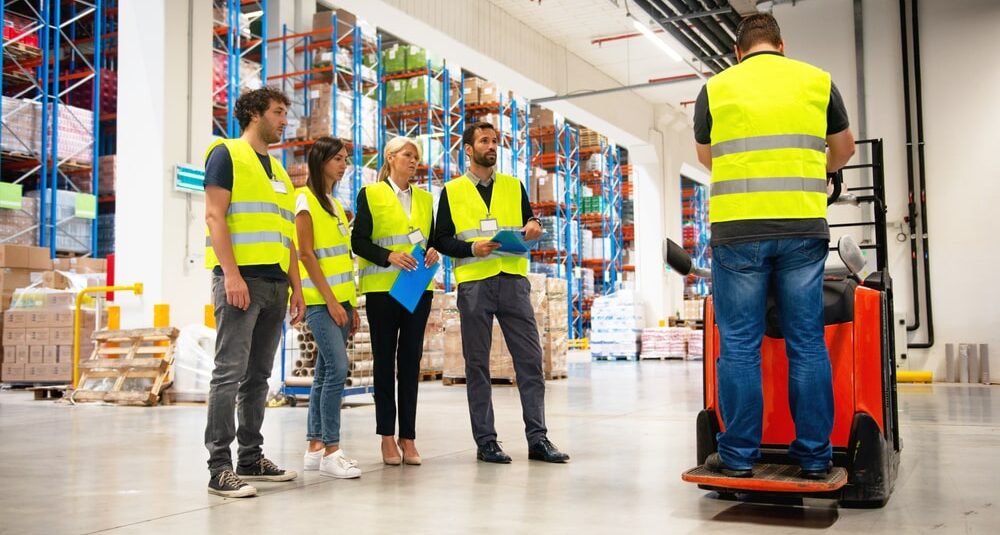Did you know that forklift accidents can cause severe injury and even death? Although these practical machines are among the most valuable assets on the job site, they require extreme caution. For this reason, forklift training in Calgary is essential. When operating heavy equipment, safety should always be the priority.
A safe job site enables workers to complete their tasks and return home safely to their families. And understanding the rules of forklift safety can help ensure that outcome. With that in mind, here are the top 10 rules of forklift safety.
1. Ensure only trained employees operate the forklift
Forklift certification in Calgary includes the basics of using a forklift. Understanding these fundamentals is critical for a safe workplace. As a result, only individuals who have been trained through a comprehensive course should operate forklifts. A good quality course will teach you how to:
- Drive and steer
- Lift and deposit loads
- Navigate tricky areas
- Operate the forklift responsibly
With proper authorization and training, workers can safely operate a forklift on a construction site. Even if it’s a two-minute job to move the forklift a few feet away, operators must be authorized and trained.
2. Inspect the forklift before using it
Before using the forklift, always thoroughly inspect it. The equipment should be in good working condition with no repairs required. This inspection is outlined by the manufacturer and can be found in the equipment manual.
Such assessments will ensure the forklift is in good working condition. Consequently, you, as the operator and your fellow workers will be protected. Equipment malfunctions can cause severe or even lethal injuries. Therefore, an inspection should be mandatory every time you operate a forklift.
3. Use at a reasonable speed
A forklift's primary purpose is to transport goods safely from one location to another. The faster the speed is, the greater the risk of injury to the operator and others. For this reason, you must operate the forklift at a reasonable speed. This notion comes back to responsibility.
The average forklift weighs in the neighbourhood of 9,000 lbs. It’s not wise to throw that kind of volume around with irresponsible driving. Instead, slow down on turns and steadily change direction when needed.
4. Be mindful of your surroundings
While forklifts may be strong, they have their weaknesses. For example, they are susceptible to environmental deficiencies. An unnoticed pothole can cause significant damage to a forklift if you’re not careful. Be mindful of your surroundings in the workplace. Look out for any holes, bumps, or slippery floors. Clear away any debris or small objects before continuing on your path.
5. Wear appropriate clothing
Avoid loose clothing that can get caught in the equipment. Such apparel will not only be ruined if it gets stuck, but it could also result in injury. Casual wear is not a good idea when operating a forklift. Instead, be sure you’re outfitted in the proper attire, such as:
- High visibility vest or jacket
- Hard hat
- Steel-toe boots
- Tight-fitting overalls or jeans
6. Always load up facing the heaviest part of the machine
When driving on a ramp, the travel direction depends on whether the forklift is carrying a load or travelling without one. The general rule is that the heaviest end of the machine is oriented upslope. For example, if the operator goes up an incline with a load, they can drive up the incline with the heaviest part of the machine going up.
If they are driving upslope without a load, the heaviest part of the machine is the counterweight in the back. This notion means you should travel backwards up the slope. Adhering to this rule will help avoid a potentially dangerous rollover accident.
7. Always follow the proper load technique
Never push or pull a load with fork tips. Lift loads above the suggested weight or attempt to use a counterweight. Loads should always be secured and attached correctly. Never load or unload goods while on a ramp, as this compromises your safety. Remember, it’s always better to take extra precautions than to have a load potentially fall on someone and cause serious injury.
8. Be mindful of other people
While operating a forklift, always keep an eye on other workers. Drive slowly, be attentive to your surroundings, and honk the horn when approaching corners to alert others. As the trained driver, you are responsible for the safety of your coworkers. Never allow anyone to walk or stand under a load. Additionally, communicate directly with anyone who attempts to operate the forklift improperly.
9. Avoid abrupt stops
Sudden stops can shift the load you’re carrying and potentially cause the forklift to tip over. This fact highlights the importance of reasonable speed limits if you need to stop abruptly for safety reasons. Making such stops is difficult if you’re stepping on the gas, going full throttle. Ensure you can make these abrupt stops safely if the situation requires it.
10. Always park at a designated spot
A forklift should have a designated parking spot. Before leaving the machine, ensure it’s placed in park and the engine is off, and do a walk-around inspection. This rule has a few benefits that will make things easier for you and others on the job site:
- It makes it easy to locate the next time you require it
- Ensures it’s not blocking anyone from doing their job
- It helps keep the site void of clutter
- Reduces the chances of collisions with other forklifts
The Importance of Comprehensive Forklift Training
Comprehensive forklift training equips operators with the skills and knowledge necessary to handle forklifts safely and efficiently. A well-structured training program covers essential aspects such as equipment inspection, safe maneuvering techniques, load handling, and emergency procedures. Employers can reduce the risk of incidents and injuries on the job site by investing in and participating in proper forklift training.
Forklift Incidents in the Workplace
Before we share some of our safety tips, it’s important to understand the types of incidents that happen in the workplace. The primary causes of forklift accidents can be grouped into three main risk categories: user error, work environment, and mechanical design. A significant number of these accidents are due to inadequately trained personnel. According to OSHA, up to 70% of forklift incidents could have been prevented with adequate training.
Here are the leading causes of fatal forklift accidents, as identified by the Industrial Truck Association:
- Vehicle tip-over 42%
- Crushed by a vehicle 36%
- Struck or run over by a forklift 10%
- Struck by falling material 8%
- Fall from the fork platform 4%
The leading cause of forklift fatalities is overturned vehicles. Factors contributing to tip-overs include user errors such as improper turning, driving with elevated loads, sudden stops or turns, and environmental factors like unstable surfaces and unclear forklift lanes.
Improving Safety with Forklift Training
While these rules of forklift safety are helpful, investing in comprehensive forklift training and regular refresher courses is essential for maintaining a safe workplace. Proper training enhances the safety of forklift operators, protects other workers, and reduces the risk of costly accidents.
Regular refresher courses are just as important as initial training. These courses help operators stay current with the latest safety protocols and refine their skills.
AIP Safety offers both forklift training courses and refresher courses designed to meet current CSA Standard Requirements and comply with Occupational Health and Safety regulations.

